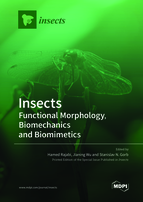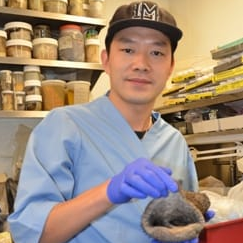Insects: Functional Morphology, Biomechanics and Biomimetics
A special issue of Insects (ISSN 2075-4450).
Deadline for manuscript submissions: closed (30 September 2020) | Viewed by 59378
Special Issue Editors
Interests: cuticle; insect wing; insect flight; mechanics of biological materials; biomechanics; functional morphology; biomimetics
Interests: biological attachment; functional morphology; biomechanics; biotribology; biomimetics
Special Issues, Collections and Topics in MDPI journals
Special Issue Information
Dear Colleagues,
This Special Issue of Insects is dedicated to Professor Dr. Leonid I. Fransevich, a corresponding member of the Ukrainian National Academy of Sciences and Professor Emeritus at Schmalhausen Institute of Zoology, Kiev, Ukraine, for his work in insect functional morphology, physiology and biomechanics and on the occasion of his 85 birthday.
Leonid Frantsevich was born in 1935 in Kiev, Ukraine. He graduated from the Faculty of Biology of the Shevchenko Kiev State University with a diploma in Biology–Zoology. He defended his PhD thesis “Fauna of Lepidoptera of the Middle Dnieper Valley” (1963) and his doctoral (habilitation) dissertation “Visual analysis of space in insects” (1981), both in Entomology. For over 40 years, he has been working at the Schmalhausen Institute of Zoology of the Ukrainian National Academy of Sciences, where he currently holds the position of leading researcher.
Professor Fransevich made a number of important discoveries in the studies of insects, in particular, for the first time he discovered such a phenomenon as the ability of animals to recognize random two-dimensional images by their texture. He showed astro orientation in Coleoptera during homing and identified structural elements of the olfactory center in insect brain (glomeruli of the deutocerebrum) by morphological characteristics. He described and experimentally studied a new type of proprioceptor (arcular organ) in Coleoptera. He demonstrated the spatial stability of visual orientation behind local and astro landmarks in insects during homing on inclined surfaces. He proposed an orientation model using polarized sky light based on a standard polarization sensitivity direction map embedded in the retinal structure and demonstrated the spatial stability of topological signs of visual key stimuli in insects.
Leonid Frantsevich was the first to use the skeletal model of the kinematic system of walking insects for the purpose of describing and analyzing movements, solving the inverse kinematics problem for reconstructing the joint angles, which are not directly observed. Using inverse kinematics methods, he studied in detail the kinematics of locomotor maneuvers in walking insects: turns on a plane, overturns, walking on thin rods, turning at the end of a thin rod, as well as the kinematics of opening-closing elytra in Coleoptera. He contributed to the research on kinematics and mechanism of deployment of the arolium (a sticky pad at the insect pretarsus) and the role of pre-stressed structures in this process. Having studied the mechanics of the composed middle coxa in dipterans, Leonid Frantsevich showed that this structure is a marker of the body segment to which the leg is attached, and discovered manifestations of homeosis (the appearance of a structure in another body segment) in certain dipteran taxa.
From Autumn 1986 to 1988, Leonid Frantsevich headed the work of Kiev zoologists in the Chornobyl NPP site and the Exclusion Zone. At that time, his research developed in two directions: radioecological and general ecological ones. He calculated the volume of the removal of the radionuclides from the Exclusion Zone by migratory birds and then proposed an integral estimate of the offset as a product of three quantities. The resulting estimate turned out to be insignificant in comparison with the total removal of radionuclides outside the zone and did not require specific countermeasures.
In 1989–1994, Leonid Frantsevich and his colleagues carried out a wide bioindication of 90Sr pollution of water bodies and land on the basis of the beta radioactivity of mollusk shells. Maps of 90Sr pollution of the Kiev region and rivers of the Dnieper basin were compiled. The experience of data generalization for multi-species collections was used to reconstruct the radioactive pollution of various species of wild animals based on the study of a few representative species, which are accepted as comparison standards. This standardization made it possible to depict the radionuclide contamination of wild animals on a map (2000). Based on the methods of processing multicomponent collections, Leonid Frantsevich created the first model for optimizing the permissible levels of radionuclides in food (1997).
Leonid Frantsevich was the first to draw attention to the fact that, in most of the exclusion and resettlement zones (over 98% of the total area—about 3 thousand km2), the course of events in biocenoses was determined not by the harmful effect of radiation, but rather by the removal of anthropogenic pressure on wildlife after the evacuation of the population, large-scale engineering interventions. Research and accounting of general ecological patterns were needed for the management of the alienated territories. He proposed the concept of a mosaic reserve of the Exclusion Zone with the allocation of scientifically or nature-protected lands. The principle of the mosaic reserve was approved by the Scientific and Technical Council under the Administration of the Exclusion Zone.
Leonid Frantsevich have been very successful and productive (over 150 original publications and related books, the most significant of which are "Visual analysis of space in insects" (1980), "Spatial orientation of animals" (1986) and "Animals in the radioactive zone" (1991). During his career he has received several awards for his many contributions to science, including State prize of the USSR (1987), State prize of the Ukraine (2004)) and being elected as a corresponding member of the Ukrainian National Academy of Sciences (1990), to name a few.
We are organizing a Special Issue honoring Prof. Dr. Frantsevich’s distinguished scientific career over the past 60 years. This Special Issue will consist of original research articles and review articles related to functional morphology and biomechanics of insects, his favorite topic.
Dr. Hamed Rajabi
Prof. Dr. Stanislav N. Gorb
Dr. Jianing Wu
Guest Editors
Manuscript Submission Information
Manuscripts should be submitted online at www.mdpi.com by registering and logging in to this website. Once you are registered, click here to go to the submission form. Manuscripts can be submitted until the deadline. All submissions that pass pre-check are peer-reviewed. Accepted papers will be published continuously in the journal (as soon as accepted) and will be listed together on the special issue website. Research articles, review articles as well as short communications are invited. For planned papers, a title and short abstract (about 100 words) can be sent to the Editorial Office for announcement on this website.
Submitted manuscripts should not have been published previously, nor be under consideration for publication elsewhere (except conference proceedings papers). All manuscripts are thoroughly refereed through a single-blind peer-review process. A guide for authors and other relevant information for submission of manuscripts is available on the Instructions for Authors page. Insects is an international peer-reviewed open access monthly journal published by MDPI.
Please visit the Instructions for Authors page before submitting a manuscript. The Article Processing Charge (APC) for publication in this open access journal is 2600 CHF (Swiss Francs). Submitted papers should be well formatted and use good English. Authors may use MDPI's English editing service prior to publication or during author revisions.
Keywords
- structure
- evolution
- scaling
- materials
- locomotion
- robotics
- design
- bioinspiration









